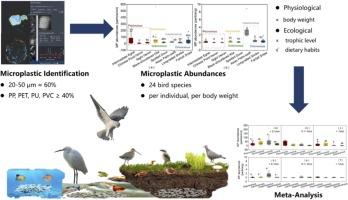当前位置:
X-MOL 学术
›
J. Hazard. Mater.
›
论文详情
Our official English website, www.x-mol.net, welcomes your
feedback! (Note: you will need to create a separate account there.)
Species-specific Accumulation of Microplastics in Different Bird Species from South China: A Comprehensive Analysis
Journal of Hazardous Materials ( IF 12.2 ) Pub Date : 2024-11-20 , DOI: 10.1016/j.jhazmat.2024.136607 Ying Zeng, Junjie Cai, Yujing Zhu, Jichao Wang, Rui Guo, Li Jian, Xiaobo Zheng, Bi-Xian Mai
Journal of Hazardous Materials ( IF 12.2 ) Pub Date : 2024-11-20 , DOI: 10.1016/j.jhazmat.2024.136607 Ying Zeng, Junjie Cai, Yujing Zhu, Jichao Wang, Rui Guo, Li Jian, Xiaobo Zheng, Bi-Xian Mai

|
Microplastics are widespread in many bird species, but the inter-specific variations of microplastic contamination are still unclear. The present study measured microplastics in 24 bird species from South China and investigated the impacts of bird physiological and ecological traits on microplastic contamination. The median abundances of microplastics ranged between 5-167.2 particles per individual or 0.023-3.58 particles per g body weight. Approximately 60% of microplastics were within the size range 20-50 μm, with the primary polymer types of polypropylene (PP) and polyethylene terephthalate (PET). There was no significant correlation between microplastic abundances and bird body weights and trophic levels (δ15N) in different bird species. Insectivorous birds had significantly higher abundances of microplastics smaller than 0.1 mm than granivorous, piscivorous, and carnivorous birds (p < 0.01), which was further supported by the meta-analysis of microplastic contamination in birds. On contrary, meta-analysis results indicate that piscivorous birds tend to accumulate larger microplastics (> 1 mm) than other bird species. Microplastic contamination in different bird species was more influenced by diet source rather than trophic level and body weight. Potential ecotoxicological risks were observed for most insectivorous species in the preliminary risk assessment. Particular concern should be paid on insectivorous birds, which have been scarcely studied for microplastics but were at high exposure risks of microplastics among bird species.
中文翻译:

华南地区不同鸟类微塑料的物种特异性积累:综合分析
微塑料在许多鸟类中广泛存在,但微塑料污染的种间差异仍不清楚。本研究测量了华南地区 24 种鸟类的微塑料,并调查了鸟类生理和生态特性对微塑料污染的影响。微塑料的中位丰度范围为每人 5-167.2 个颗粒或每克体重 0.023-3.58 个颗粒。大约 60% 的微塑料在 20-50 μm 的尺寸范围内,主要聚合物类型为聚丙烯 (PP) 和聚对苯二甲酸乙二醇酯 (PET)。不同鸟类的微塑料丰度与鸟类体重和营养水平 (δ15N) 之间没有显著相关性。食虫鸟类小于 0.1 毫米的微塑料丰度明显高于花岗食性、食鱼性和肉食性鸟类 (p < 0.01),这得到了鸟类微塑料污染的荟萃分析的进一步支持。相反,荟萃分析结果表明,食鱼鸟类往往比其他鸟类积累更大的微塑料(> 1mm)。不同鸟类的微塑料污染受饮食来源的影响更大,而不是营养水平和体重。在初步风险评估中观察到大多数食虫物种存在潜在的生态毒理学风险。应特别关注食虫鸟类,这些鸟类很少研究微塑料,但在鸟类中,这些鸟类暴露于微塑料的风险很高。
更新日期:2024-11-20
中文翻译:

华南地区不同鸟类微塑料的物种特异性积累:综合分析
微塑料在许多鸟类中广泛存在,但微塑料污染的种间差异仍不清楚。本研究测量了华南地区 24 种鸟类的微塑料,并调查了鸟类生理和生态特性对微塑料污染的影响。微塑料的中位丰度范围为每人 5-167.2 个颗粒或每克体重 0.023-3.58 个颗粒。大约 60% 的微塑料在 20-50 μm 的尺寸范围内,主要聚合物类型为聚丙烯 (PP) 和聚对苯二甲酸乙二醇酯 (PET)。不同鸟类的微塑料丰度与鸟类体重和营养水平 (δ15N) 之间没有显著相关性。食虫鸟类小于 0.1 毫米的微塑料丰度明显高于花岗食性、食鱼性和肉食性鸟类 (p < 0.01),这得到了鸟类微塑料污染的荟萃分析的进一步支持。相反,荟萃分析结果表明,食鱼鸟类往往比其他鸟类积累更大的微塑料(> 1mm)。不同鸟类的微塑料污染受饮食来源的影响更大,而不是营养水平和体重。在初步风险评估中观察到大多数食虫物种存在潜在的生态毒理学风险。应特别关注食虫鸟类,这些鸟类很少研究微塑料,但在鸟类中,这些鸟类暴露于微塑料的风险很高。


















































 京公网安备 11010802027423号
京公网安备 11010802027423号